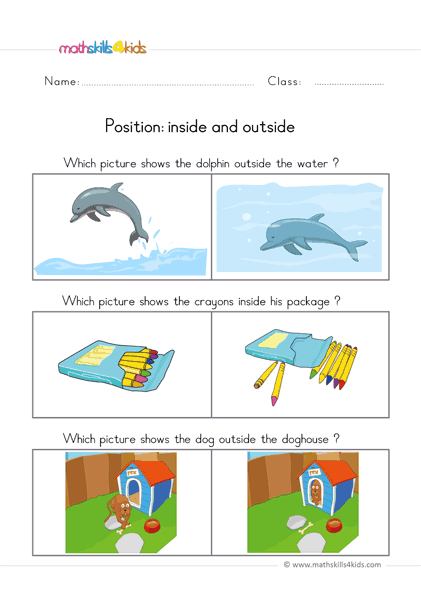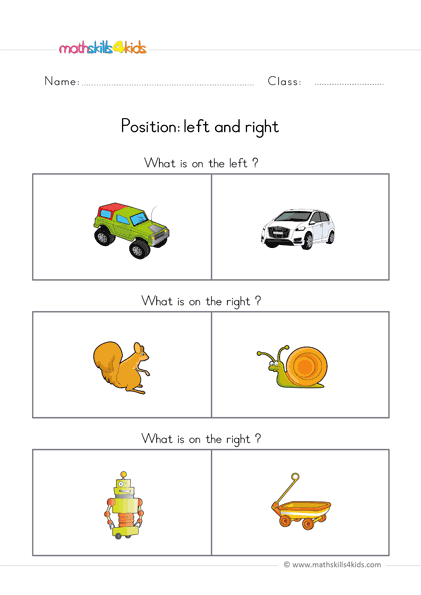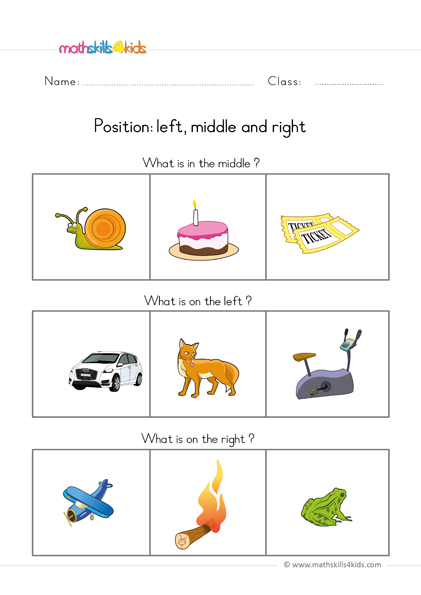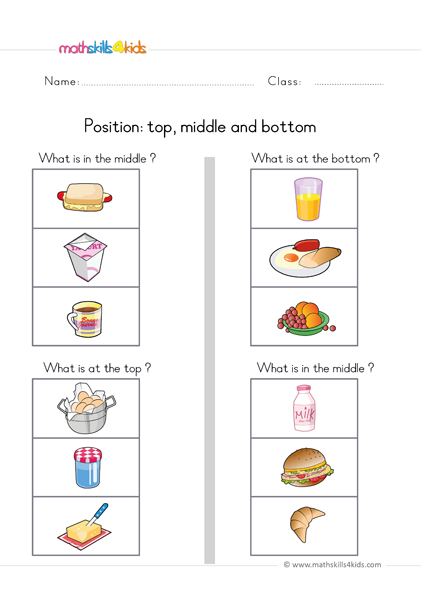Preschool position worksheets: A fun way to teach spatial concepts
Do your kids struggle with learning positional or spatial concepts such as: up and down, left and right, near and far on, beside, next to, and on top of? If yes, then get started with these fun preschool position worksheets and watch your child's spatial awareness skills grow!
You might think teaching your child positional words requires just pointing out things at home from left to right, up and down, etc. Oh no! It will become so tiring and boring for them.
-
What about finding a fun way to teach these spatial concepts to them? We've got it all here. After engaging in this printable positional words learning resource, you'll realize that learning spatial relationships can be a fun and engaging experience for them.
However, this printable set of position worksheets is all about preschoolers learning, reviewing, and reinforcing their spatial awareness skills in a fun and interesting way.
What are Preschool Position Worksheets? - Introduce basic positional vocabulary
Preschool position worksheets are printable activities that help young children learn about the concepts of location, direction, and movement. They are designed to teach children how to use words such as above, below, inside, outside, left, right, etc.
This idea of introducing basic positional vocabulary to preschoolers will inspire them to incorporate positional language into their everyday play-based interactions and activities.
Also, this early learning of positional words is a building block for more advanced spatial concepts, such as those related to geometry and measurement.
Positional words describe the location or direction of an object in relation to another object. For example, in the sentence "The cat is under the table," the word "under" is a positional word that tells us where the cat is.
Preschool position worksheets can also help children develop fine motor skills, visual perception, and logical thinking.
-
BROWSE THE WEBSITE
-
DOWNLOAD FREE WORKSHEETS
-
-
-
Why are preschool position worksheets important for early learning?
Preschool position worksheets are important for early learning because they help children develop their spatial awareness, vocabulary, and math skills. Spatial awareness is the ability to understand and manipulate objects in space. It is essential for many everyday tasks, such as reading maps, following directions, playing games, and solving problems.
Vocabulary is the set of words that a person knows and uses. The great thing about positional words is that we use them daily, most times without even realizing it. So, constantly using or learning these positional words can enrich a child's vocabulary and help them communicate more clearly and effectively. Math skills are the abilities to perform calculations and reason logically.
Learning positional words can prepare a child for many cognitive and motor skills, such as reading, writing, math, art, science, sports, and navigation. Reasoning skills are the ability to think logically and solve problems. They are crucial for academic success and everyday life.
-
How to use preschool position worksheets in the classroom or at home
Preschool position worksheets can be used in various ways in the classroom or at home to make learning fun and engaging. Here are some ideas:
- Use them as a warm-up activity before a lesson on spatial concepts or related topics.
- Use them as a review or assessment tool to check children's understanding of spatial concepts.
- Use them as a center activity or a homework assignment to reinforce spatial concepts.
- Use them as a game or a challenge by having children work in pairs or groups and take turns describing the position of objects or people on the worksheet.
- Use them as a creative project by having children draw their own pictures or scenes using spatial words.
-
Examples of preschool position worksheets for different themes and skills
One of the benefits of preschool position worksheets is that they can be adapted to any theme or topic that interests your child. For example, you can use animals, shapes, colors, letters, numbers, or seasonal items as the main elements of the worksheets.
Here are some examples of mathskills4kids.com preschool position worksheets for different themes and skills:
- Inside and outside: This worksheet helps children learn the difference between inside and outside by asking them to circle the items inside the house and cross out the outside items. You can use any type of house or building as the background and any items that fit the theme. For example, you can use a barn and farm animals, a castle and fairy tale characters, or a school and school supplies.
- Right and left: This worksheet helps children learn the concepts of right and left by asking them to color the items on the right side of the page one color and the items on the left side another color. You can use items that clearly distinguish right and left, such as shoes, gloves, ears, eyes, or hands.
- Left, middle, and right: This worksheet helps children learn the concepts of left, middle, and right by asking them to cut out the pictures at the bottom of the page and paste them in the correct position on the top of the page. You can use any type of picture with three parts or segments: a caterpillar, a train, or a sandwich.
- Top, middle, and bottom: This worksheet helps children learn the concepts of top, middle, and bottom by asking them to draw a line from each item on the left side of the page to its matching position on the right side. You can use any item with different heights or levels, such as a tree, a ladder, or a cake.
-
Use visual aids to reinforce positional concepts
Visual aids are a great way to reinforce the concepts your child is learning through the preschool position worksheets. Use toys or objects to demonstrate the different positions and ask your child to identify them.
You can also use pictures or drawings to help your child visualize the concepts. By using visual aids, you can help your child better understand spatial relationships and improve their overall learning experience.
-
Incorporate hands-on activities
To make learning about spatial relationships even more engaging, incorporate hands-on activities into your child's education. Use blocks or other manipulatives to create different positions and ask your child to identify them.
You can also have your child draw or color pictures of objects in different positions. By incorporating hands-on activities, you can help your child develop their fine motor skills while also reinforcing the concepts they are learning.
-
Practice spatial relationships with real-life scenarios
One of the best ways to teach spatial relationships to preschoolers is by using real-life scenarios. Take your child on a walk and point out different objects and their positions, such as a tree next to a sidewalk or a car parked in a driveway.
You can also use everyday objects in your home, such as a cup on a table or a toy on the floor, to teach your child about different positions. By incorporating real-life scenarios, you can help your child understand how spatial relationships apply to their everyday life.
-
Encourage creativity and problem-solving skills.
Using preschool position worksheets not only teaches spatial relationships but also encourages creativity and problem-solving skills. As children work through the activities, they are challenged to think critically about the positions of objects and how they relate to each other. This helps to develop problem-solving skills that will benefit them in many areas of life.
Additionally, the open-ended nature of the activities allows for creativity and imagination to flourish, which is important for overall cognitive development.
Tips and resources for creating your own preschool position worksheets
If you want to create your own preschool position worksheets, here are some tips and resources to help you:
- Use simple and clear instructions that your child can understand. For example, instead of saying, "Circle the item that is inside the house," you can say, "Find what is in the house. Circle it."
- Use colorful and attractive images that capture your child's attention. You can find free clip art online or draw your own pictures.
- Use different types of activities to keep your child engaged. For example, you can use coloring, cutting, pasting, tracing, drawing, or matching activities.
- Use different types of paper or materials to make your worksheets more fun. For example, you can use construction paper, cardstock, stickers, glitter glue, or magnets.
- Use online tools or templates to make your worksheets easily. For example, you can use Canva (https://www.canva.com/), Worksheetfun (https://www.worksheetfun.com/), or Education.com (https://www.education.com/) to create your own preschool position worksheets.
-
Thank you for sharing the links of MathSkills4Kids.com with your loved ones. Your choice is greatly appreciated.
Preschool position worksheets are a fun and educational way to teach spatial concepts to your child. They can also help your child develop other skills, such as vocabulary, math, and fine motor skills. Try some of these examples or create your own preschool position worksheets for different themes and skills.
Happy teaching!





